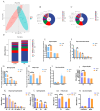Mulberry Leaf Dietary Supplementation Can Improve the Lipo-Nutritional Quality of Pork and Regulate Gut Microbiota in Pigs: A Comprehensive Multi-Omics Analysis
- PMID: 38672381
- PMCID: PMC11047539
- DOI: 10.3390/ani14081233
Mulberry Leaf Dietary Supplementation Can Improve the Lipo-Nutritional Quality of Pork and Regulate Gut Microbiota in Pigs: A Comprehensive Multi-Omics Analysis
Abstract
Mulberry leaves, a common traditional Chinese medicine, represent a potential nutritional strategy to improve the fat profile, also known as the lipo-nutrition, of pork. However, the effects of mulberry leaves on pork lipo-nutrition and the microorganisms and metabolites in the porcine gut remain unclear. In this study, multi-omics analysis was employed in a Yuxi black pig animal model to explore the possible regulatory mechanism of mulberry leaves on pork quality. Sixty Yuxi black pigs were divided into two groups: the control group (n = 15) was fed a standard diet, and the experimental group (n = 45) was fed a diet supplemented with 8% mulberry leaves. Experiments were performed in three replicates (n = 15 per replicate); the two diets were ensured to be nutritionally balanced, and the feeding period was 120 days. The results showed that pigs receiving the diet supplemented with mulberry leaves had significantly reduced backfat thickness (p < 0.05) and increased intramuscular fat (IMF) content (p < 0.05) compared with pigs receiving the standard diet. Lipidomics analysis showed that mulberry leaves improved the lipid profile composition and increased the proportion of triglycerides (TGs). Interestingly, the IMF content was positively correlated with acyl C18:2 and negatively correlated with C18:1 of differential TGs. In addition, the cecal microbiological analysis showed that mulberry leaves could increase the abundance of bacteria such as UCG-005, Muribaculaceae_norank, Prevotellaceae_NK3B31_group, and Limosilactobacillus. Simultaneously, the relative levels of L-tyrosine-ethyl ester, oleic acid methyl ester, 21-deoxycortisol, N-acetyldihydrosphingosine, and mulberrin were increased. Furthermore, we found that mulberry leaf supplementation significantly increased the mRNA expression of lipoprotein lipase, fatty acid-binding protein 4, and peroxisome proliferators-activated receptor γ in muscle (p < 0.01). Mulberry leaf supplementation significantly increased the mRNA expression of diacylglycerol acyltransferase 1 (p < 0.05) while significantly decreasing the expression of acetyl CoA carboxylase in backfat (p < 0.05). Furthermore, mulberry leaf supplementation significantly upregulated the mRNA expression of hormone-sensitive triglyceride lipase and peroxisome proliferator-activated receptor α (p < 0.05) in backfat. In addition, mulberry leaf supplementation led to increased serum leptin and adiponectin (p < 0.01). Collectively, this omic profile is consistent with an increased ratio of IMF to backfat in the pig model.
Keywords: intramuscular fat; lipid profile; lipidomic; mulberry leaves; triglyceride.
Conflict of interest statement
The authors declare that they have no conflicts of interest to report regarding the present study.
Figures






References
-
- Kong C., Yang L., Gong H., Wang L., Li H., Li Y., Wei B., Nima C., Deji Y., Zhao S., et al. Dietary and Food Consumption Patterns and Their Associated Factors in the Tibetan Plateau Population: Results from 73 Counties with Agriculture and Animal Husbandry in Tibet, China. Nutrients. 2022;14:1955. doi: 10.3390/nu14091955. - DOI - PMC - PubMed
LinkOut - more resources
Full Text Sources
Research Materials

